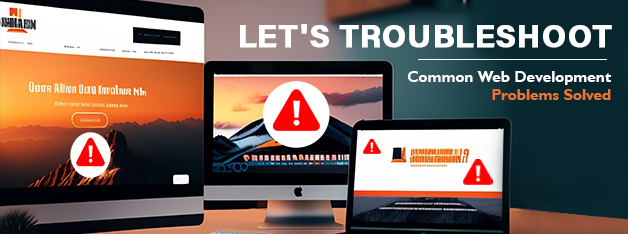Let’s Troubleshoot: Common Web Development Problems Solved

Introduction:
Hello, fellow web developers! We all know that web development can sometimes be a bumpy road filled with unexpected challenges. But fear not, because in this blog post, we’re going to tackle some common web development problems together. From mysterious bugs to cross-browser compatibility issues, we’ve got you covered. So, let’s roll up our sleeves and get ready to troubleshoot like pros!
Problem 1: The Dreaded CSS Bug
You’re happily styling away when suddenly, a stubborn CSS bug appears. Elements aren’t aligned correctly, colors are off, and frustration starts to creep in. Fear not, because the first step is to inspect the elements using your browser’s developer tools. Check for conflicting styles, missing closing brackets, or selectors targeting the wrong elements. A little detective work here usually does the trick!
Problem 2: JavaScript Woes
Ah, JavaScript, the language of interactivity and sometimes, headaches. If you encounter JavaScript errors or unexpected behavior, start by checking your browser’s console for error messages. They’ll give you valuable clues about what went wrong. Make sure your JavaScript syntax is correct, check for missing semicolons, and verify that all functions are called properly. Debugging like a pro will save the day!
Problem 3: Cross-Browser Compatibility Chaos
Your website looks flawless in one browser, but in another, it’s a disaster. Fear not, for cross-browser compatibility issues are a common challenge. Start by checking if the problematic browser supports the CSS properties and JavaScript methods you’re using. Consider using CSS vendor prefixes and JavaScript polyfills to provide compatibility with older browsers. Testing your site on multiple browsers throughout development is key to identifying and addressing compatibility quirks.
Problem 4: Performance Pains
A slow-loading website can drive visitors away faster than you can say “optimize.” To tackle performance issues, begin by analyzing your site’s assets. Optimize image sizes and formats, minify CSS and JavaScript files, and leverage browser caching. Consider lazy loading images and loading JavaScript asynchronously to improve initial page load times. Tools like Google PageSpeed Insights can provide valuable insights and suggestions for further optimization.
Problem 5: Forms Misbehaving
Forms are an integral part of many websites, but they can be a source of frustration when they misbehave. If your forms aren’t submitting or validating correctly, start by checking your HTML markup. Ensure that form elements have the appropriate attributes, such as action and method for the form tag. Validate user inputs both on the client-side using JavaScript and on the server-side to maintain data integrity and security.
Problem 6: Mobile Responsiveness Woes
In the mobile-first era, responsive design is a must. If your website doesn’t look or function properly on mobile devices, it’s time to tackle those responsiveness woes. Use media queries to adapt your layout for different screen sizes. Test your site on various mobile devices and use device emulators to simulate different screen resolutions. Pay attention to font sizes, button sizes, and touch-friendly interactions to provide an optimal mobile experience.
Problem 7: SEO Snags
Search engine optimization (SEO) is crucial for driving organic traffic to your website. If your site isn’t ranking as expected, start by ensuring your HTML structure follows best practices. Use proper heading tags (h1, h2, etc.), include relevant meta tags, and provide descriptive alt attributes for images. Ensure your website has a crawlable structure and that your content is optimized for relevant keywords. Regularly monitor your site’s performance in search engine rankings and make necessary adjustments.
Conclusion:
Web development is an exciting journey filled with opportunities to learn and grow. When you encounter common problems like CSS bugs, JavaScript issues, cross-browser compatibility challenges
